ITEAD Studio very recently launched their Sonoff S26 WiFi Smart plug as a more compact and cost effective upgrade to their Sonoff S20 smart sockets, and which comes in 6 different versions for China, Australia, the United Kingdom, the United States, Europe type F for Germany, Austria, the Netherlands, Sweden, Finland, Norway, Portugal, Spain and Eastern Europe, and Europe type E for France, Belgium, Poland, Slovakia, the Czech Republic, Tunisia and Morocco. You can find the one that suits you most on World Standard website.
I was interested in getting the device, mostly to check the hardware design, so the company sent me one sample to try out.
Sonoff S26 Unboxing
Sonoff S26 comes is a white package with Sonoff branding.
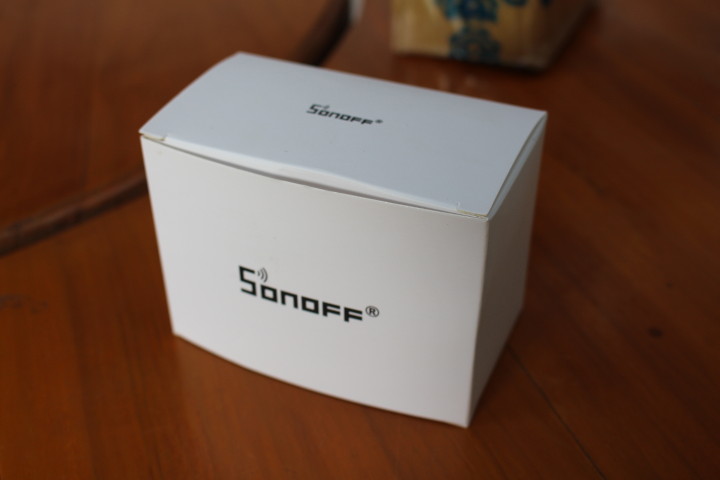
I received the US type plug (S26B model) which includes a ground pin on both side, so it’s not suitable for most sockets here in Thailand that do not come with ground, but no problem, I’ll use a power extension.
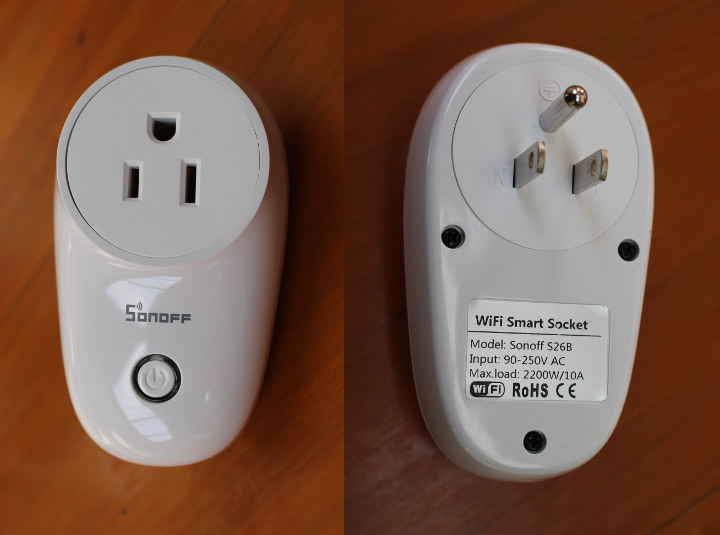
We can also see the CE logo but nothing for FCC. Interesting for a supposedly US plug, but maybe that’s because they are in the process of applying for FCC certification. The company has not done any TUV, ETL or UL safety certification yet, so at this point, it’s the job of the community to check for any safety issues, and it may cause trouble with your home insurance in case of big problem (like fire).
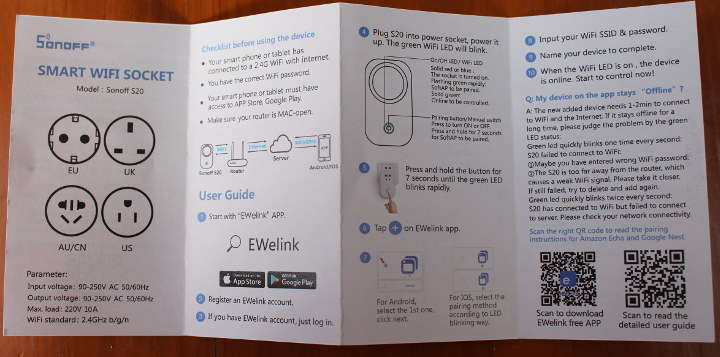
A user manual is also included, and since Sonoff S26 should be functionally the same as Sonoff S20, they did not bother to change it with the model shown as “Sonoff S20”. They details user guide is available in English, German, French, Italian, Spanish, Japanese, Russia, and Portuguese here.
Sonoff S26 teardown
ITEAD has not made it hard to open the device, nor use the sticker “trick” to void your warranty if you open it. Just remove the three screws on the cover comes off very easily.
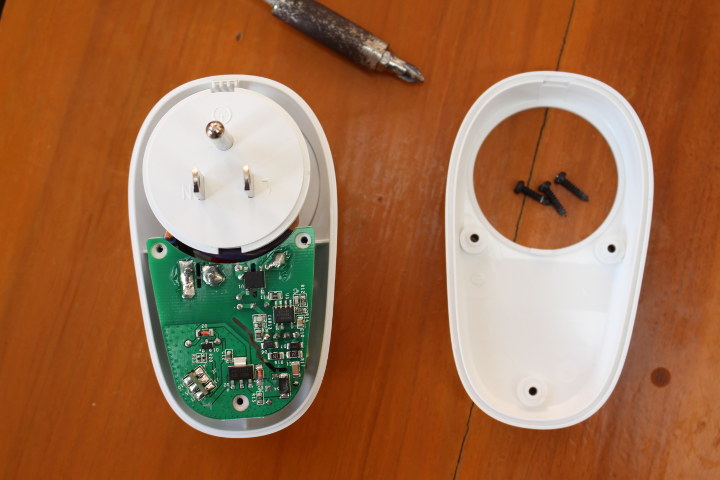
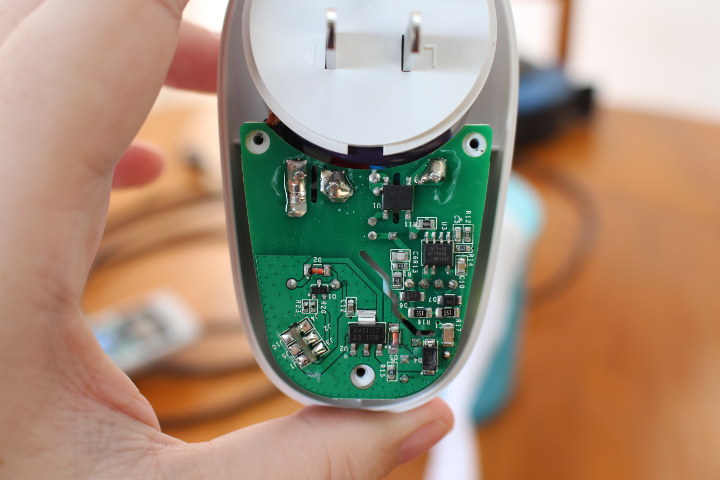
There’s thick solder on the high voltage pins and a gap between neutral and live pins, which should be a good thing. That side of the board includes three main chips:
- AMS1117 voltage regulator
- A component marked 1511-36 6774958 UB1547 that should be a power management chip
- ABS8 bridge rectifier
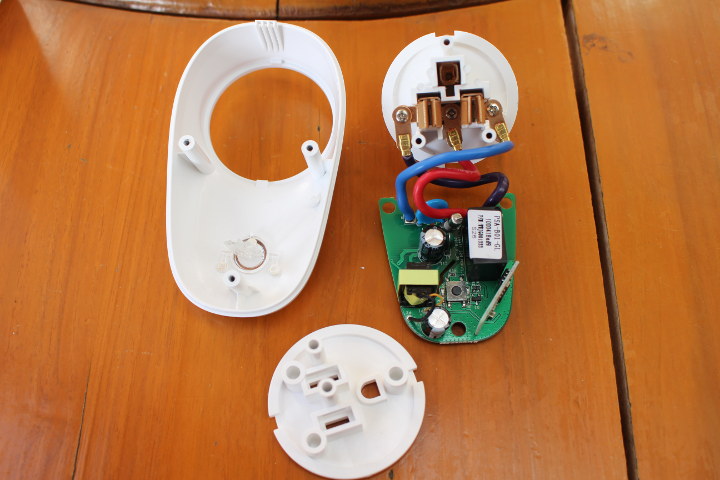
Click to Enlarge We can completely remove the board, and potentially the prong cover very easily but just pulling them out.
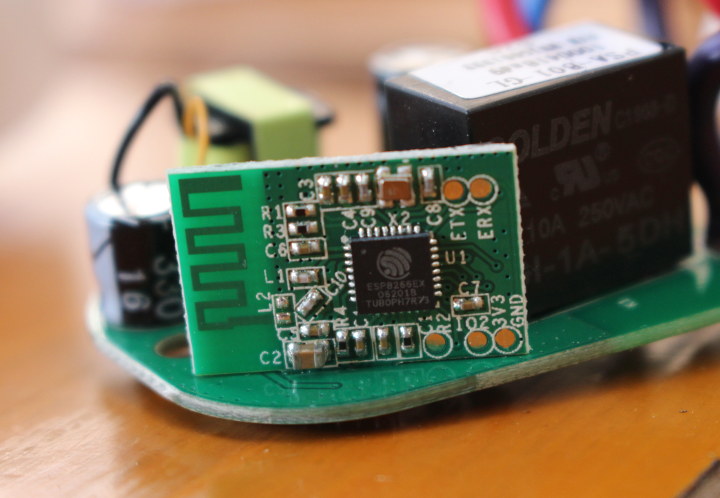
Sonoff S26 is also based on Espressif Systems ESP8266 WiSoC, but if you plan to tinker with it by connecting the serial soldering will be a little more difficult than usual since it has be done on solder pads. Sonoff-Tasmota community discussed about the plug and said the current firmware should be compatible. If the stock firmware to Sonoff-Tasmosta OTA method still works, you would not even need to open the smart socket to switch to the open source firmware. I have not tried it (yet) as it takes some time to setup everything.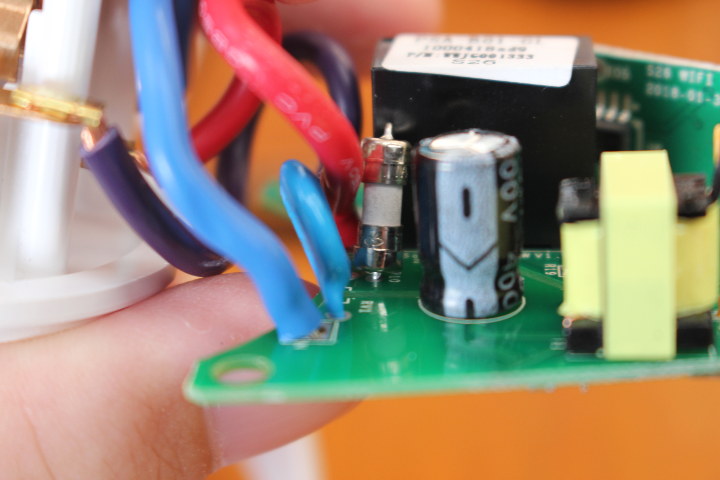
One person expressed concerns about the lack of fuse during S26 announcement, but as we can see on the photo above, there’s one fitted, it’s just not made to be user replaceable. I would still be possible to replace it but soldering is required. For reference, the plug is rated 2200W, 90-250V/10A max. So if you connect anything more powerful than that, the fuse should blow up preventing any risk of overheating and fire.
A Quick try with eWelink Android app
We’ve previously tested eWelink Android app with other Sonoff devices, including support for Google Assistant, Alexa, and iFTTT, so I won’t go into to many details, but I still tried it.
Pressing the button for 7 seconds on the smart plug makes it enter pairing made, and within a few seconds to a minute, I could easily add the device in eWelink app, and start using it to turn on and off the fan.
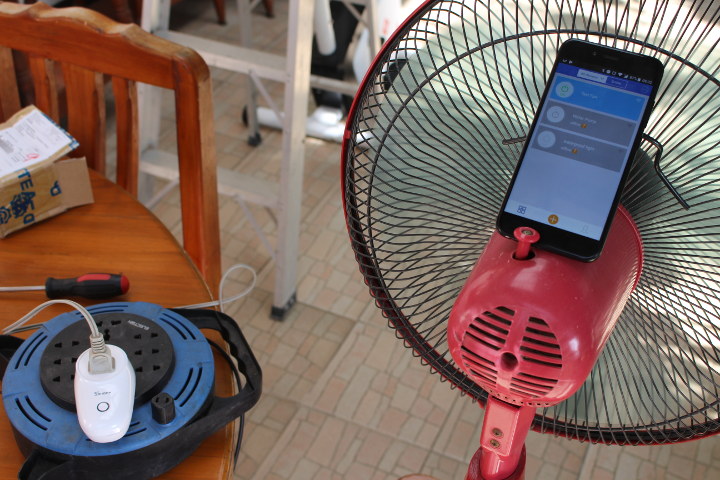
So it works just like any other eWelink device, and from the look of the hardware design it looks to be designed safely, including with an enclosure made of fire-retardant material.
Sonoff S26 is also aggressively priced as the US type plug I received sells for just $8.50 plus shipping. The China version is the same price, but the EU, AU and UK versions – which you can purchase from the same link – go for one dollar more at $9.50.

Jean-Luc started CNX Software in 2010 as a part-time endeavor, before quitting his job as a software engineering manager, and starting to write daily news, and reviews full time later in 2011.
Support CNX Software! Donate via cryptocurrencies, become a Patron on Patreon, or purchase goods on Amazon or Aliexpress





Hi,
I think that the fuse is identical to the one in the new revision of sonoffs TH16 and only the current powering the socket electronics passes through it. It should be in the range of several hundred milliamperes. The main current does not seem to pass through any fuse in the socket.
Best regards,
Svetozar
If you look at the top and bottom photos of the PCB, the fuse + blue capacitor are connected to the live and neutral, as I see it.
“the fuse + blue capacitor are connected to the live and neutral” – the capacitor yes, but the fuse can’t logically be such a configuration (across live and neutral).
I think you will find that the capacitor is connected from the neutral (blue) side across to the live (red) side of the bridge rectifier, while the fuse provides a path between live (red) and the live(red) side of the bridge rectifier, so protecting the local electronics. For the fuse to be protecting the live supply it would have would have to be placed between live (red) and the relay or the relay and live (black), but the soldering indicates that both red and black wires are directly soldered to the relay pins.
This leaves the 10A 250V relay operating as the over current protection, which at least in the UK where 32A+ ring mains are used and loads can be rated at 13A means the device is very unsafe.
Maybe I should do a test with a high load and see what happens. I just need to find a better power extension, as all the ones I have are rated for 10A.
Any views on insect proof or not?
Apply transparent nail polish, it will work in protecting SMD components.
“The company is still not doing any TUV, ETL or UL safety certification for their products”
So if you buy and use this you are an idiot right?
It is a mine field and uk actuion sites, are full of cut price no safety versions of this type of device. Under many brand names.
I would say so since devices from this vendor have a history of catching on fire. And it is not like 500 people have told them to go get certified. They are simply refusing to do it.
Jon, I can’t count the times you’ve written your piece about the sonoff devices catching fire as if this is a constantly occurring problem. In fact every time I see a post about something sonoff here I make a little bet with myself about how long it’ll be before you show up. While I’m sure if we really dig we could find instances of a fire happening I can’t find all the reports of dead kittens and puppies that there should be if there is a problem on the scale your comments suggest.
In fact the first result on google for “sonoff fire” is John Ward severely over loading a sonoff and it not bursting into flames.
Yes Jon, we all get it. They should do UL testing and get the nice logo on the package. We both know they won’t do it because it’ll cost money and thus cut into their profit margins.
FYI The commonly stated as fact “If you have non-UL listed stuff in your house your insurance won’t pay out” thing seems to be a myth. I can’t find one instance of someone actually proving this is in the terms and conditions of their insurance policy.
I’m grateful to Jon for always pointing out the safety problems. It’s hard for a non expert to be aware otherwise.
>Jon for always pointing out the safety problems
But he (and others) doesn’t point out where the actual problems are. They keep saying “why no UL testing”. We know why there is no UL testing. It’s made in China and imported illegally. They could give two shits about your insurance company trying to chase them after having to pay out on someone’s house burning down.
If we’re going to bring this up every time for a sonoff product then they should also bring it up for everything posted here that includes a cheap mains adapter too.
And if you really care about the testing bringing it up here over and over and over doesn’t help anyone. Report sellers that are illegally selling products without the required certification until Amazon etc take notice.
My mother bought a blouse made in China last week and the label inside the collar said CE.
So sadly, even if these certification letters are printed on the device, it means nothing.
If they burn your house down, it’s just their word against yours. 🙁
Nothing to see here. From 1 year ago and earlier replies.
Different product
http://support.iteadstudio.com/support/discussions/topics/11000012976
I’ve seen that post before and it looks like itead did a board revision to work around that issue. Aside from what looks like it internally overheating I’m not seeing where it actually caught fire and killed the guys new born baby and goldfish.
Does the post above show something that 100% won’t occur in a UL listed product? Nope. UL listed stuff has caused actual house fires. The only difference is that the insurance people have someone to go after.
Feel free to put non-UL or ETL approved stuff in your house, it’s your house you can do what you want with it. It’s not like those non-UL approved hoverboards caught on fire and burned someone’s house down. One of many stories….
https://abcnews.go.com/US/fire-sparked-hoverboard-destroys-nashville-mansion-authorities/story?id=36816675
I build this stuff commercially and the stuff I work on has UL/ETL approval. It is not consumer gear so I don’t work for a competitor. I own a lot of home automation gear and anything I leave powered 24/7 has UL/ETL approval.
All new hoverboards now have UL/ETL or they can’t be imported. Have you heard of any hoverboard fires lately?
There are lots of choices for UL/ETL approved equipment – wemo, tp-link, insteon, lutron, GE, intermac, etc all have either UL or ETL approval.
>Feel free to put non-UL or ETL approved stuff in your house,
I don’t live in the US so I have lots of non-UL stuff in my house.
>it’s your house you can do what you want with it.
Sure is. Thank you for confirming my property rights.
>It’s not like those non-UL approved hoverboards
But those non-UL approved hoverboards aren’t the sonoff things you come to claim catch fire all the time on every single post about said sonoff things are they?
UL approved things have killed many people, caused many fires etc. The UL approved smoke alarms that didn’t work.
>caught on fire and burned someone’s house down. One of many stories….
>https://abcnews.go.com/US/fire-sparked-hoverboard-destroys-nashville-mansion-authorities/story?id=36816675
Unless itead starts making sonoff branded hoverboards I’m not sure what any of this has to do with your original claim of “devices from this vendor have a history of catching on fire”.
>I build this stuff commercially and the stuff I work on has UL/ETL approval.
So? I have worked on products that have UL listing. I’ve seen photos of said product after they’ve been hit by lightening etc. UL listing didn’t stop stuff like that happening.
>I own a lot of home automation gear and anything I leave powered 24/7 has UL/ETL approval.
Awesome. So when you do have the misfortune to have a house fire because of some situation that UL testing didn’t account for i.e. because you put something in a toaster that got stuck and UL testing doesn’t actually test that failure mode you can feel great that at least your house fire is UL approved?
>All new hoverboards now have UL/ETL or they can’t be imported.
I’m still not seeing how hoverboards became sonoff products but anyhow.. the problem with hoverboards was poor charging circuits/poor quality batteries was it not? We’ve seen UL (+ other international bodies) tested phones and chargers burst into fire have we not? Maybe Lilo/Lipo batteries are dangerous when not treated correctly or UL testing doesn’t mitigate human error.
And technically the sonoff stuff shouldn’t be for sale in the US should it? Surely the unlisted hoverboards shouldn’t have been for sale either? It’s like the regulatory body cartel doesn’t actually work over there.
>There are lots of choices for UL/ETL approved equipment – wemo, tp-link,
>insteon, lutron, GE, intermac, etc all have either UL or ETL approval.
Again, irrelevant to your original claim that sonoff stuff is catching fire. You of all people should know that safety testing isn’t all about avoiding a bit of PCB getting charred because of gross overloading but also about how the product fails. You can see for yourself in John Wards videos that after gross overload the sonoff switch he tested got charred and the case melted but it didn’t catch fire or sustain a fire. I suspect they wouldn’t have much problem throwing a few $K at a testing lab to get a certificate. Again you should know that testing labs in China give out certificates for stuff that isn’t really up to spec all day long. I have a bunch of radio modules on my desk that have had “real” compliance testing, have a shiny cert to prove it and can’t possibly be compliant (power output far in excess of what is allowed, firmware doesn’t implement LBT, firmware is user modifiable etc).
That aside the reason people come here for news on interesting/hackable gadgets is it not? The sonoff stuff is popular because you can upload firmware that isn’t full of calls to a random server in China right?
Uploading said firmware would invalidate most approvals wouldn’t it?
TL;DR; I don’t really get why you bring up something that basically amounts to FUD over and over again on a site that is all about stuff that is at best of questionable legality visited by people that get annoyed when banggood etc stop shipping 18650 cells in a jiffy bag via standard airmail.
As for the insurance aspect. You have to go read your policy. If you are paying extra for fire insurance with an “all peril” clause then they will cover everything except for a licensed electrician making a mistake (and then it goes on his insurance). Everything will include non-UL/ETL device fires.
If you don’t have the “all peril” clause a fire started by a non-UL/ETL device can turn in to a big fight as to who is responsible.
>If you don’t have the “all peril” clause a fire started by
>a non-UL/ETL device can turn in to a big fight as to who is responsible.
Do you have any examples of that happening and the fight being between the insurance company and the home owner?
This is another FUD piece that people are putting out there with apparently zero evidence to actually validate their claims.
Would you look at that.. A bunch of down votes but not a single link to an actual example. Who would have thunk it.
I am not entirely convinced this new device is really smaller then S20.
At least for S20 US version this is obviously inaccurate as it is 102x62x38.5
Personally I just hope, they release their switch in a “square” form factor, something similar to the Kankun KK-SP3 of old.
ITEAD Studio told me they are going through ETL certification for Sonoff IW100, IW101, IW102.
That is great news. Passing fire safety inspection is just common sense.
Great news. Should stop all of their hoverboards catching on fire.
Checked my S26 EU-F model, the fuse does not protect the main current through the socket.
My S20 EU-F does, so why not in the S26 (I would say safety first) !!!?
In my opinion, the fuses & fuse holders in older batches of the TH series were a reason for excessive heat generation under heavy load. Some fuse holders on the market are rated only up to 6.3 amps of load and the fuse itself also contributes to the heat. In my particular case, Itead reacted in a professional and user-friendly manner and sent me new versions of the devices. In the replacements, the fuse configuration was similar to S26. I also have one S20, where – if I remember correctly – the fuse is also in a configuration similar to S26.